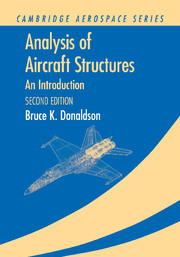Book contents
- Frontmatter
- Contents
- Introduction to the Second Edition
- Introduction to the First Edition
- List of Repeated Engineering Symbols
- Acknowledgments
- Part I The Fundamentals of Structural Analysis
- Part II **Introduction to the Theory of Elasticity**
- Part III Engineering Theory for Straight, Long Beams
- Part IV Work and Energy Principles
- 15 Work and Potential Energy Principles
- Part V Energy-Based Numerical Solutions
- Part VI Thin Plate Theory and Structural Stability
- Appendix A Additional Topics
- Appendix B Selected Answers to Exercises
- References
- Index
15 - Work and Potential Energy Principles
from Part IV - Work and Energy Principles
Published online by Cambridge University Press: 05 June 2012
- Frontmatter
- Contents
- Introduction to the Second Edition
- Introduction to the First Edition
- List of Repeated Engineering Symbols
- Acknowledgments
- Part I The Fundamentals of Structural Analysis
- Part II **Introduction to the Theory of Elasticity**
- Part III Engineering Theory for Straight, Long Beams
- Part IV Work and Energy Principles
- 15 Work and Potential Energy Principles
- Part V Energy-Based Numerical Solutions
- Part VI Thin Plate Theory and Structural Stability
- Appendix A Additional Topics
- Appendix B Selected Answers to Exercises
- References
- Index
Summary
Introduction
In Parts I and III, equilibrium equations are established via Newton's laws by summing the forces and moments acting on isolated (free) bodies. Equilibrium equations assure continuity of forces and moments. Continuity of displacements is established by requiring either that (i) the orthogonal displacement or deflection components are described by differentiable functions in the case of a displacement formulation, or (ii) the strain compatibility equations are satisfied in the case of a stress formulation. Since the stresses acting upon fixed surfaces are vector quantities, and the displacement and deflection components are also vector quantities, the methods of Parts I, II, and III are often called “vector methods.” This chapter introduces an alternate approach to vector methods. This alternate approach, called “energy methods,” is often analytically superior to vector methods, particularly for complex problems. Energy methods have the same bases as vector methods. That is, just like vector methods, energy methods can be based upon Newton's laws and the same geometric description of structural deformations. However, energy methods involve scalar quantities such as work and potential energy. The shift from vector quantities to work and potential energy results in four important advantages.
The first advantage of energy methods is that the work or energy statements permit the choice of any coordinate system without a change in form for the basic equations.
- Type
- Chapter
- Information
- Analysis of Aircraft StructuresAn Introduction, pp. 479 - 520Publisher: Cambridge University PressPrint publication year: 2008



